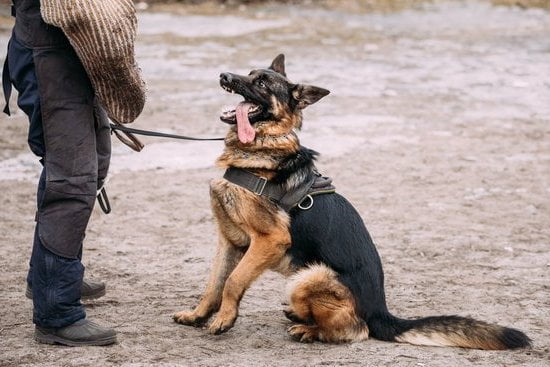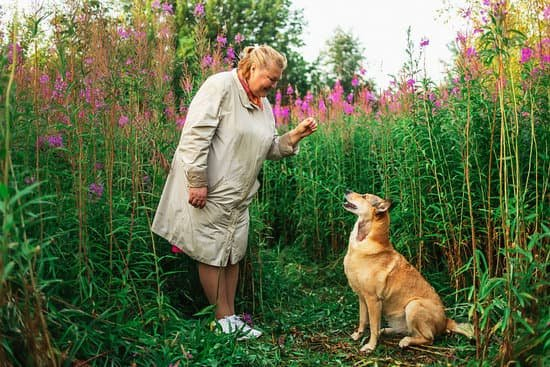Training a dog without the use of food can be a rewarding and fulfilling experience for both you and your furry companion. This article will explore the various methods and techniques that can be employed to effectively train your dog without relying on food rewards. From understanding the psychology of dog training to addressing behavioral issues, we will delve into the importance of building trust, effective communication, and alternative reward systems in training your dog.
Many dog owners rely heavily on food rewards when training their pets, but it is important to understand the benefits of non-food training methods. By utilizing positive reinforcement, trust-based training, and alternative rewards such as play and toys, you can develop a strong bond with your dog while promoting obedience and good behavior. Additionally, creating a consistent training schedule and celebrating successes without food rewards can further reinforce positive behavior in your furry friend.
In this article, we will explore how to effectively communicate with your dog through verbal and physical cues, as well as overcome challenges such as behavioral issues without resorting to food rewards. By understanding the psychology of dog training and implementing non-food training methods, you can establish a strong foundation for a well-behaved and obedient canine companion.
Understanding the Psychology of Dog Training
Training a dog without the use of food rewards can be highly effective in building a strong and trusting relationship with your furry friend. Understanding the psychology of dog training is crucial in order to use positive reinforcement methods that do not rely on treats. Positive reinforcement involves rewarding your dog for good behavior, but this does not always have to involve food.
To train your dog without food, it’s important to understand the principle of positive reinforcement versus food rewards. Positive reinforcement involves providing praise, affection, or other forms of non-food rewards to reinforce good behavior in your dog. This method focuses on creating a strong bond between you and your pet, built on trust and cooperation.
When training your dog without food rewards, it’s essential to incorporate verbal and physical cues as part of effective communication. Using clear commands and body language can help your dog understand what is expected of them during training sessions. By consistently using these cues, you can reinforce positive behaviors without resorting to treats.
In addition to using verbal and physical cues, incorporating play and toys as alternative rewards for training can be highly effective. Dogs often respond well to playtime as a form of reward for good behavior. Interactive toys or games can provide mental stimulation and physical exercise for your pet, while also reinforcing their positive actions during training sessions.
- Positive reinforcement includes using praise, affection, or non-food rewards
- Verbal and physical cues are important forms of communication during training
- Playtime and toys can be used as alternative rewards for good behavior
Building a Strong Bond With Your Dog
Here are some trust-based training methods that can help you build a strong bond with your dog:
- Positive reinforcement: Instead of relying solely on food rewards, use praise, petting, and affection to reinforce good behavior. When your dog follows a command or exhibits the desired behavior, shower them with love and attention.
- Trust-building exercises: Engage in activities that promote trust and teamwork, such as agility training, obedience training, or interactive playtime. These exercises not only strengthen the bond between you and your dog but also provide mental stimulation and physical exercise.
In addition to positive reinforcement and trust-building exercises, non-verbal communication plays a crucial role in building a strong bond with your dog. Pay attention to your body language and learn to interpret your dog’s cues. Understand their likes, dislikes, fears, and preferences to create a harmonious relationship based on mutual respect and understanding.
By incorporating these trust-based training methods into your routine, you can establish a solid foundation for effective communication and cooperation with your dog without relying on food rewards.
Finally, remember that building a strong bond with your dog takes time and patience. Be consistent in your approach and celebrate small victories along the way. Your dedication to trust-based training will ultimately lead to a deeper connection with your furry friend based on love, respect, and mutual trust.
Incorporating Verbal and Physical Cues
When it comes to training your dog without using food, effective communication through verbal and physical cues is essential. Dogs are highly receptive to non-verbal signals and body language, so it’s important to understand how to effectively communicate with them during training sessions.
Body Language
Using body language is a powerful tool when training your dog without food. Dogs are very observant of human body language, so be sure to use open and inviting postures to encourage positive behavior. Conversely, closed off or aggressive body language can signal fear or anxiety in your dog, leading to negative responses.
Voice Commands
Verbal cues are also crucial in non-food training. Consistency in the commands you use will help your dog understand what is expected of them. Be sure to use a firm but gentle tone of voice when giving commands and praise your dog immediately when they respond correctly.
Hand Signals
In addition to verbal cues, hand signals can also be an effective form of communication during non-food training. Simple gestures accompanied by clear verbal commands can help reinforce the desired behavior in your dog. It may take some time for your dog to learn these signals, so be patient and consistent in their use.
By incorporating these verbal and physical cues into your training regimen, you can effectively communicate with your dog without relying on food rewards. Establishing clear communication will strengthen the bond between you and your furry companion while promoting positive behavior.
Utilizing Play and Toys
When it comes to training your dog without food, utilizing play and toys as alternative rewards can be highly effective. Not only does it provide a fun and interactive way to reinforce positive behavior, but it also strengthens the bond between you and your furry friend.
Choosing the Right Toys
When using toys as rewards for training, it’s important to choose the right ones that best suit your dog’s preferences. Some dogs may be more motivated by a game of fetch with a tennis ball, while others may prefer a tug-of-war with a rope toy. By understanding what type of toys your dog enjoys the most, you can make training sessions more engaging and rewarding for them.
Interactive Play Sessions
Incorporating interactive play sessions into your training routine can create a stimulating environment for your dog. Whether it’s playing hide-and-seek, engaging in agility exercises, or participating in obedience games, these activities not only serve as rewards for good behavior but also help in mental stimulation and physical exercise for your dog.
Training Through Play
Using play as a reward during training sessions allows you to weave obedience commands seamlessly into playful activities. For example, teaching your dog to sit before throwing a toy or asking them to bring back the toy before starting another round of play can reinforce obedience while making the learning process enjoyable for your pet.
By integrating play and toys as alternative rewards in your non-food training regimen, you can create an enriching experience for both you and your dog while achieving successful results in their behavior and obedience.
Creating a Training Schedule
Consistency and patience are key components of training a dog without using food rewards. Just like with any type of training, consistency is crucial in reinforcing the desired behaviors in your dog. It’s important to establish a regular training schedule that includes short, frequent training sessions.
This will help your dog understand what is expected of them and create a routine that they can rely on. Setting aside dedicated time each day for training will also show your dog that you are committed to their learning and development.
In addition to consistency, patience is equally important when training a dog without food rewards. It’s essential to understand that non-food based training methods may take longer for your dog to grasp compared to traditional food-based training.
Be patient with your dog and avoid showing frustration or impatience during training sessions. Keep in mind that every dog learns at their own pace and maintaining a calm and patient demeanor will help create a positive learning environment for your furry friend.
Another aspect of creating a training schedule without food involves finding the right balance between repetition and variety in the training activities. Repetition helps reinforce learned behaviors, but it’s also important to introduce new challenges and exercises to keep your dog engaged and motivated. Strike a balance between practicing known commands and introducing new ones, all while adhering to the established training schedule.
Training without food rewards requires dedication, consistency, and patience from the pet owner. By establishing a regular training schedule, remaining patient during the learning process, and balancing repetition with variety in the exercises, you can effectively train your dog without relying on food rewards as incentives.
Overcoming Challenges
Training a dog without food can pose some challenges, especially when addressing behavioral issues. However, it is entirely possible to overcome these challenges by using alternative methods that focus on positive reinforcement and trust-building. One effective approach is to use praise and physical affection as rewards for good behavior. By doing so, you can reinforce positive behaviors while addressing any behavioral issues your dog may have.
In addition to praise and affection, another alternative method for addressing behavioral issues without food rewards is the use of toys and playtime. Many dogs are highly motivated by play, and using this as a reward can be just as effective as food. For example, if your dog has a behavioral issue such as jumping on guests, you can redirect their behavior with a favorite toy or engage them in a game of fetch to reinforce the appropriate behavior.
It’s also important to remember that consistency and patience are key when overcoming behavioral challenges without food rewards. Dogs thrive on routine and clear expectations, so establishing a training schedule and sticking to it is essential. By consistently using alternative rewards and methods such as verbal cues, physical affection, playtime, and toys, you can effectively address behavioral issues without relying on food rewards.
| Approach | Benefits |
|---|---|
| Praise and Affection | Reinforces positive behavior; builds trust |
| Toys and Playtime | Motivates through play; redirects inappropriate behavior |
| Consistency and Patience | Establishes clear expectations; fosters trust and understanding |
Celebrating Success
In conclusion, training a dog without using food rewards is not only possible but also a valuable way to build a strong bond and trust with your canine companion. By understanding the psychology of dog training and utilizing positive reinforcement techniques, you can effectively communicate with your dog and encourage desirable behaviors without relying on food treats.
Building a strong bond with your dog through trust-based training methods is essential for successful non-food training. By incorporating verbal and physical cues, as well as utilizing play and toys as alternative rewards, you can reinforce positive behavior and achievements in your dog without relying on food rewards. This not only strengthens the bond between you and your dog but also allows for a deeper level of communication and understanding between the two of you.
Creating a consistent training schedule and showing patience in non-food training methods will help overcome challenges and address behavioral issues without the need for food rewards. Celebrating success by reinforcing positive behavior through praise, attention, and affection will further motivate your dog to continue exhibiting these desirable behaviors. When done correctly, training a dog without using food rewards can be just as effective, if not more so, than traditional food-based training methods.
Frequently Asked Questions
How Do You Train a Dog That Is Not Food Driven?
Training a dog that is not food driven requires finding an alternative motivator, such as toys or praise. Using playtime or affection as a reward can help reinforce desired behaviors in a non-food motivated dog.
How Do I Train My Dog to Sit Without Treats?
Training your dog to sit without treats involves gradually reducing the frequency of treat rewards and incorporating verbal praise and physical affection instead. Consistency and patience are key to transitioning away from food rewards.
How Do I Train My Dog Not to Eat Anything?
Teaching your dog not to eat anything involves supervising them closely, especially during walks or outdoor activities. Using commands like “leave it” and “drop it” can help redirect their attention from potential hazards. Consistent training and positive reinforcement are crucial in teaching this important behavior for their safety.

Welcome to the blog! I am a professional dog trainer and have been working with dogs for many years. In this blog, I will be discussing various topics related to dog training, including tips, tricks, and advice. I hope you find this information helpful and informative. Thanks for reading!





